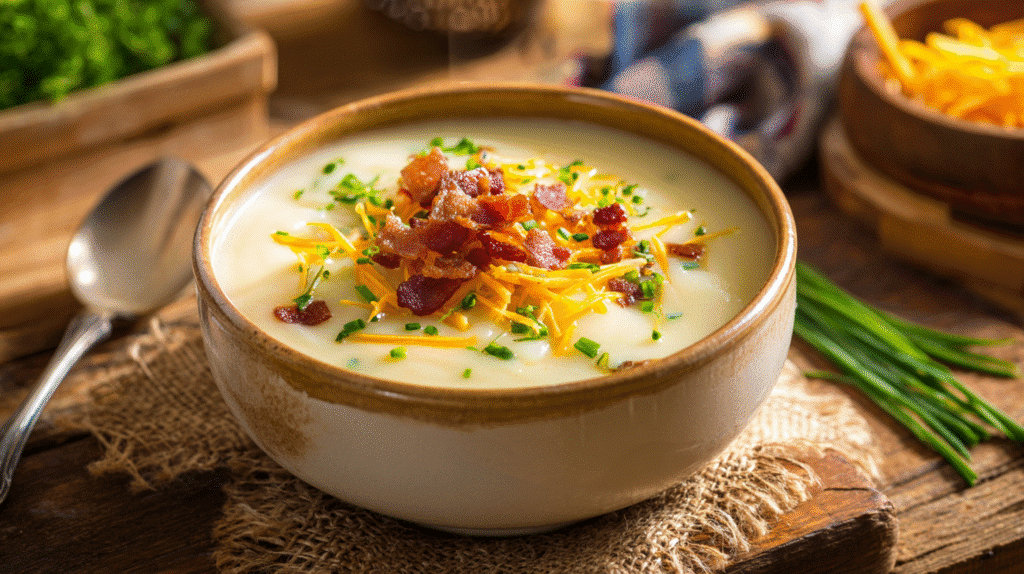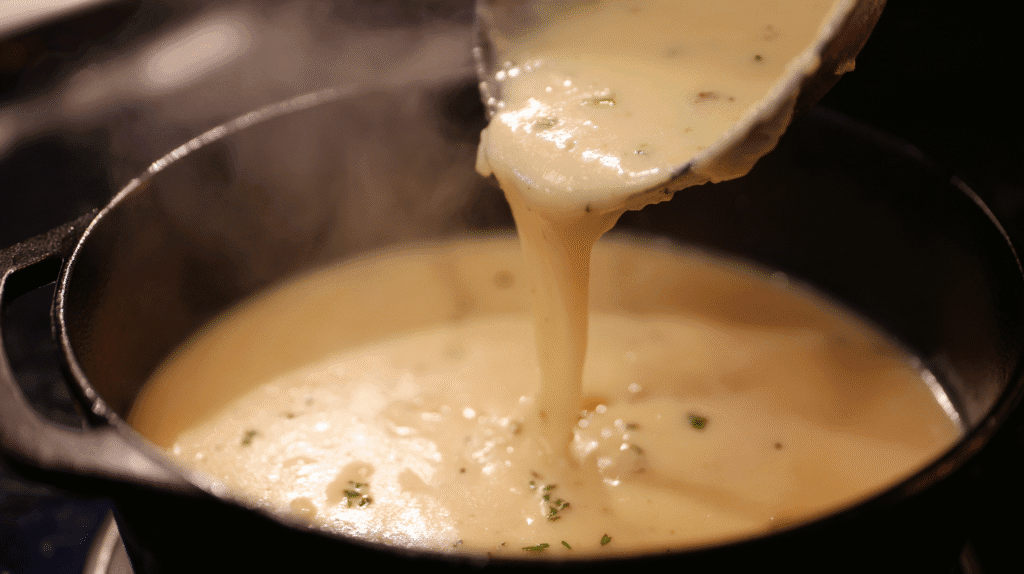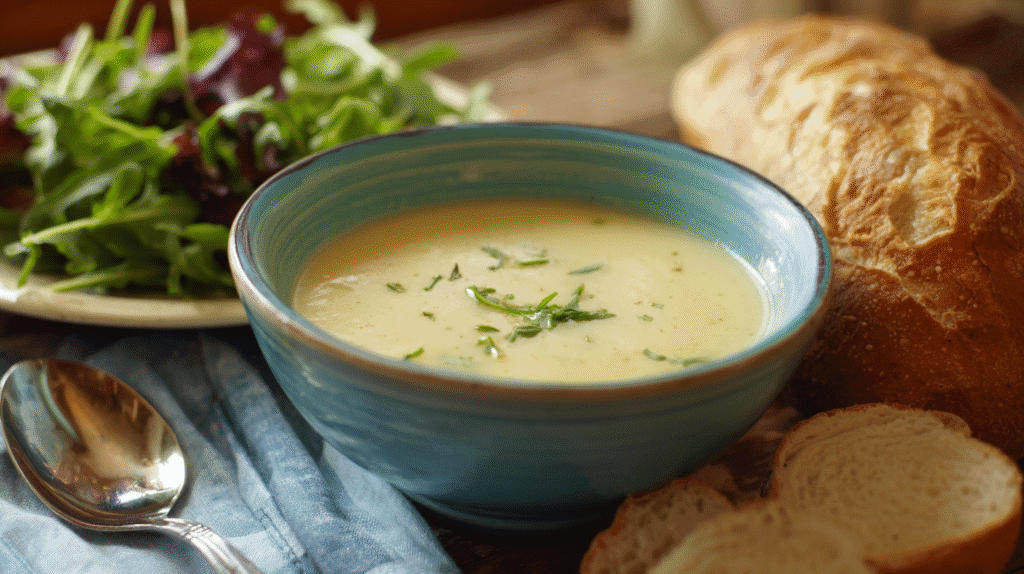
Creamy potato soup has a way of bringing comfort to even the dreariest days. I’m Olivia Barnes, and here in my Cotswolds kitchen, it’s the dish I turn to when the weather turns crisp and the hearth starts glowing. This simple, satisfying soup takes me back to my childhood, when my grandmother would ladle steaming spoonfuls into our bowls with hands that always smelled of thyme and flour.
We didn’t cook from fancy books. Instead, we used what grew in our garden—like the same earthy potatoes that now fill my own pantry. Over time, creamy potato soup became my weeknight hero. As a mum of three, I needed recipes that were filling, easy, and used what I already had. This one never let me down.
Whether you keep it traditional or load it up with toppings, this soup wraps you up like a warm blanket. For more cozy meals that bring people together, you might enjoy my Broccoli Cheddar Soup or browse more Comfort Food Recipes that carry the same nostalgic warmth.
PrintCreamy Potato Soup Recipe – Cozy, Thick, and Easy to Make
Creamy potato soup made with russet potatoes, butter, and cream—rich, velvety, and perfect for cold nights
- Prep Time: 10 mins
- Cook Time: 30 mins
- Total Time: 40 mins
- Yield: 4 servings 1x
- Category: Soup
- Method: Stovetop
- Cuisine: British
- Diet: Vegetarian
Ingredients
4 large russet potatoes, peeled and diced
1 small onion, finely chopped
2 tablespoons butter
2 cloves garlic, minced
3 cups vegetable or chicken broth
1 cup whole milk
1/2 cup heavy cream
Salt and pepper to taste
1/2 teaspoon dried thyme
Optional: cooked bacon, shredded cheddar, chopped chives
Instructions
Melt butter in a large pot over medium heat. Sauté onion and garlic until soft.
Add diced potatoes and broth. Simmer for 15–20 minutes until potatoes are fork-tender.
Blend half the soup for a creamy texture, then return to pot.
Stir in milk, cream, thyme, salt, and pepper. Simmer gently for another 5–10 minutes.
Serve hot with toppings like bacon, cheese, or chives.
Notes
Blend more or less for desired consistency.
Substitute cream with plant-based milk for a vegan version.
Store leftovers in fridge for up to 4 days or freeze in airtight containers.
Nutrition
- Serving Size: 1 bowl
- Calories: 320
- Sugar: 4g
- Sodium: 780mg
- Fat: 18g
- Saturated Fat: 9g
- Unsaturated Fat: 8g
- Trans Fat: 0g
- Carbohydrates: 34g
- Fiber: 3g
- Protein: 6g
Why Creamy Potato Soup Feels Like Home
A cottage classic I grew up with
My first bowl of creamy potato soup came from my grandmother’s battered enamel pot. She’d pull potatoes from the garden, pour in milk from the morning’s delivery, and stir slowly while telling stories. That soup didn’t just fill us—it stayed with us. It taught me that great food isn’t complicated—it’s thoughtful.
Now in my own kitchen, I carry those same principles. I often pair this soup with one of my easy one-pot recipes, especially when I want something fuss-free and comforting after a long day.
What makes a great creamy potato soup?
The answer lies in starchy potatoes like russets—they naturally thicken the broth. Whole milk or cream brings body, while butter finishes the soup with a velvety richness. Blending part of the soup (or all, depending on your texture preference) helps you get that perfect creamy finish.
Adding a touch of sour cream or a handful of shredded cheese can take it to the next level. And don’t underestimate a bay leaf or fresh thyme—they bring quiet depth. If you’re planning a freezer-friendly batch, just remember to let it cool fully before storing to preserve that luscious texture.
Looking to round out the meal? Try one of our crisp seasonal salads for contrast, or a soft slice from our bread collection to mop up every drop.
Table of Contents
Ingredients and Preparation Tips for Creamy Potato Soup

The secret to perfect creamy texture of creamy potato soup
The real magic behind creamy potato soup lies in getting the texture just right. For the creamiest base, try to go with Yukon Gold potatoes. These starchy varieties break down beautifully during cooking and help thicken the soup without needing flour or thickeners. I love adding a mix of heavy cream and whole milk—just enough richness without making it too heavy. A generous spoonful of butter adds depth and that silky mouthfeel.
Another trick? Don’t rush. Letting the soup simmer gently allows the flavors to develop while the potatoes soften naturally. You can also cut the potatoes smaller to speed things up. But whatever you do, avoid boiling the soup too hard—it can make the dairy split and the texture grainy.
Want to make it dairy-free? Try unsweetened oat milk with a dollop of cashew cream. I’ve even included versions of this in my plant-based comfort meals collection. The texture still holds up beautifully with just a bit of tweaking.
If you enjoy creamy classics like this, you’ll also appreciate our family-friendly dinners designed to please even picky eaters.
Potatoes in soup – do they go mushy?
They can—but only if you use the wrong kind or cook them too long. Waxy potatoes like red or new potatoes hold their shape well but don’t create that creamy finish. On the other hand, russet potatoes absorb liquid and break down slightly, which makes the soup thick and smooth without needing a blender.
The key is knowing when to stop cooking. Once your potatoes are tender enough to pierce with a fork but not falling apart, you’re in the sweet spot. At this point, you can mash half of them gently with a spoon to thicken the broth while keeping some chunks for texture.
For more weeknight wonders that don’t compromise on comfort, check out our quick soup recipes and easy one-pot ideas.
Easy Method and Delicious Variations

Step-by-step: how to make creamy potato soup
Making creamy potato soup at home is easier than you might think. Start with a large pot over medium heat. To build the base flavor, start with dicing onions, add garlic in butter, and celery until soft. Then stir in peeled and chopped russet potatoes, followed by vegetable or chicken broth. Let everything simmer until the potatoes are tender.
Once soft, you can use an immersion blender to purée the soup directly in the pot. I prefer blending about two-thirds of it—this keeps some texture while achieving a creamy finish. Stir in whole milk, cream, salt, pepper, and a pinch of dried thyme. Simmer gently for a few more minutes until everything melds into a velvety bowl of warmth.
Don’t forget the toppings. Grated cheddar, green onions, and crispy bacon or even a dollop of sour cream turn it into something special. If you’re after more satisfying soups that follow a similar one-pot method, explore my slow cooker recipes or comforting stovetop dinners.
Creative takes: loaded, spicy, or vegan-friendly
Once you’ve mastered the base, creamy potato soup becomes a canvas for creativity. Love a loaded flavor? Add shredded cheese, cooked bacon, and chives to mimic a baked potato. For something heartier, stir in sautéed mushrooms or roasted cauliflower near the end.
Craving heat? fold it in cayenne, chopped jalapeños or a dash of smoked paprika. Want to go meatless? Use olive oil instead of butter and swap the cream for unsweetened almond or oat milk. You can even thicken it with blended white beans for a protein boost.
You’ll find more swaps and tips like these in our vegan comfort food collection and among our gluten-free dishes, especially for cooks who love adapting classic recipes to fit modern needs.
Serving and Storing Creamy Potato Soup

Toppings and sides that make it shine
The beauty of creamy potato soup is how well it pairs with simple sides and creative toppings. I love serving it with crusty bread—something with a chewy interior and golden edge, perfect for dipping. If you’re making it a main course, pair it with a fresh salad, like something from our seasonal side dish collection, to cut through the richness.
Toppings can take your bowl from lovely to luxurious. Think crispy bacon crumbles, shredded sharp cheddar, sliced green onions, or a swirl of sour cream. You could even try roasted garlic or caramelized onions if you’re in the mood to dress things up. A sprinkle of smoked paprika or black pepper gives it that extra depth.
Hosting a gathering? Offer a “soup bar” setup with various toppings in little bowls. It’s easy, interactive, and everyone gets their perfect bowl. You can find more hosting tips in my crowd-pleasing family meals and dinner party favorites.
How to store and reheat it properly
Creamy potato soup stores surprisingly well, but there are a few tricks to keeping that texture silky when reheating. If you want to freeze it, ladle portions into freezer-safe containers, leaving a bit of room at the top for expansion.
Dairy-based soups can sometimes separate when frozen, but if you reheat gently over low heat and stir frequently, it comes right back together. Avoid boiling, which can cause curdling. If needed, add a splash of milk or broth to revive the consistency.
Looking to prep in bulk? You’ll love our freezer-friendly soup ideas and leftover makeover recipes that help reduce waste while making weekday meals effortless.
For more recipes follow me in Facebook and Pinterest
Conclusion
Creamy potato soup is more than just a meal—it’s a memory in a bowl. From my grandmother’s stovetop to my own busy kitchen, it’s the recipe I come back to again and again for comfort, warmth, and connection. Whether you serve it plain or dressed with all the toppings, one spoonful has a way of quieting a noisy day.
Keep experimenting, keep cooking from the heart, and if you’re ever unsure what to make on a cold night, you know just the soup to stir.
Frequently Asked Questions About Creamy Potato Soup
What makes a great creamy potato soup ?
The creaminess in potato soup comes primarily from starchy potatoes like russets, which naturally thicken the soup as they cook. Adding a mix of cream, milk, and butter enhances that smooth texture. I use similar methods in dishes like my Football Slow Cooker Favorites where comfort is key, and texture matters just as much as taste.
Do potatoes get mushy in soup?
Yes, they can if overcooked or if you use waxy varieties like red potatoes. To avoid mushiness, stick with russets or Yukon Golds and keep an eye on the simmer time—once they’re fork-tender, it’s time to blend or serve. You’ll find tips like these throughout our one-pot meals that keep texture in check.
Why is my potato soup not creamy?
There are a few possible reasons. If you used waxy potatoes, they may not break down enough to create a smooth base. Skipping cream, milk, or butter can also make the soup feel thin. Finally, not blending part of the soup will leave it chunkier than expected. Try our suggested tweaks or check out similar advice in 30-minute recipes that rely on quick, creamy techniques.
Is cream of potato soup good by itself?
Absolutely. A well-made cream of potato soup is rich and flavorful enough to be enjoyed alone. That said, toppings like cheese, bacon, or scallions can add extra depth. For example, on chilly days, it goes beautifully with a bowl of Healthy Coffee Drinks from Starbucks to warm your hands and heart.
